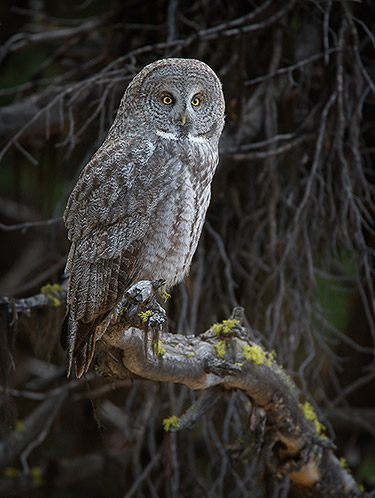The Silent Hunter, Great Gray Owl
(Click image to enlarge)
The Great Gray Owl has also been called Phantom of the North and the Great Gray Ghost. The owl's scientific name is Strix nebulosa. The word "nebulosa" is derived from the Latin "nebulosus", meaning misty or foggy. It is the largest of the North American Owls, but not the most massive, and is more gray than other owls. The feet are heavily feathered and remain hidden from view. When perched, they appear very bulky because of their dense, fluffy plumage, relatively long tail, long wings extending past the body, and a relatively large head. Great gray owls lack ear tufts. The size of their head and the prominent facial disk with concentric rings make their yellow eyes appear small. They are also distinguished by a noticeable white "moustache" strip under the facial disk and a black "bow-tie" formed by their white throat and black chin. Great gray owls hunt mainly during early morning and late afternoon, especially during winter, but they will also hunt during other daylight hours or at night. Their diet consists mostly of small mammals.
Great gray owls typically move only short distances between perches and seldom glide. They fly close to the ground, usually less than 20 feet up, except when flying to a nest. Both males and females defend their nests aggressively and have been known to drive off predators as large as black bears. Captive owls have been known to live up to 40 years of age. Mortality in the wild is often due to starvation. Natural enemies that prey on the young include great horned owls, wolverine and marten. Fatalities caused by humans include road kills, electrocutions and shootings. The main predator of the great gray owl is the great horned owl, although ravens and other small birds often harass both of these owls with great ferocity.
